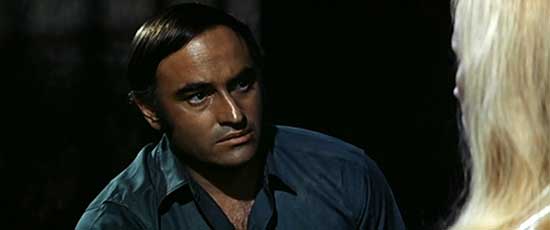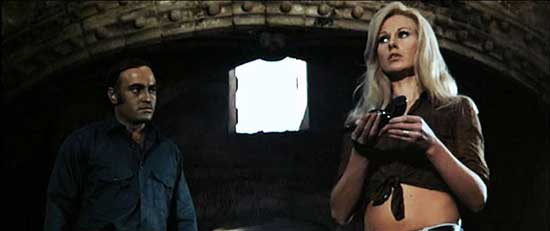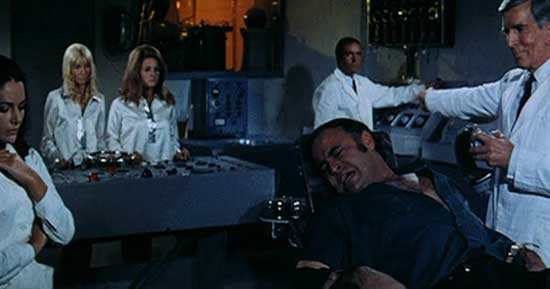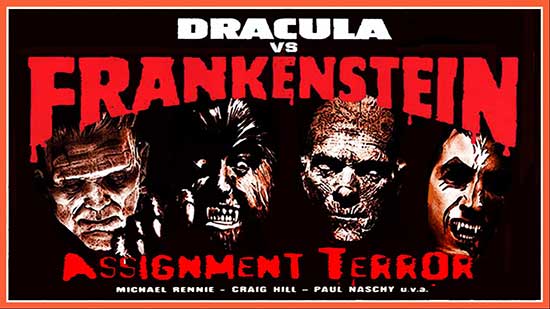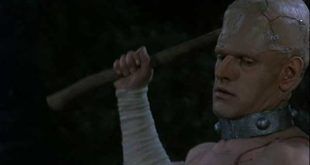Music, Monsters, and Even Spies Add Up to an Assignment: Terror
During the 1960s through the 1980s, many low-budget European horror films boasted outstanding soundtracks. Even some genuinely awful grade-B movies sported brilliant theme music. The wild classic creatures ensemble romp, The Monsters of Terror (1970), might not make much narrative sense, but you can still dance to the trippy music.
Distributor American-International Pictures changed the title to Assignment Terror for a direct-to-television U.S. release in 1973. Wisely, AIP didn’t tinker with the opening and closing credit music, which serve up some hip 1960s era sounds. Those sounds weirdly come off as simultaneously appropriate and inappropriate for a horror film.
Out-Of-This-World Music and Plots
Scoring a movie is tough work, as the composer has to pick the right sound to match the tone of a film. A film centering on invading aliens from a dying world exploiting human fears by resurrecting Dracula, the Mummy, the Frankenstein Monster*, and the Wolfman as a prelude to cloning them on a massive scale and unleashing an army of thousands on the earth people as an alternative to detonating nuclear bombs is conceptually beyond silly. Out-of-this-world silly. So, the film needs an equally fantastic soundtrack to blend well with the on-screen absurdity. A somber Hammer Film score wouldn’t entirely work. This particular film requires a little soundtrack lightheartedness.
(*Someone inexplicably rechristened the creature the “Farancksalan Monster,” perhaps to avoid litigation. BTW – The name “Frankenstein” was/is in the public domain. The look the used for the monster, however, is similar to the one trademarked by Universal. Everyone involved is lucky the studio didn’t force them to cut the monster’s scenes.)
Assignment Terror ranks as one of the more absurdly plotted horror films ever, yet the uneven picture has a quirky charm that helps it rise above disastrous production problems. The film was Paul Naschy’s follow-up to 1968’s Mark of the Wolfman/Frankenstein’s Bloody Terror. Rather than produce a direct sequel placing the Spanish horror icon’s character of Waldemar Daninsky into a starring role, writer Naschy moved the Wolfman to a supporting one, opting for a “Monster Rally” ala Universal’s House of Frankenstein. Since Naschy scored a hit with his first werewolf outing, a sequel didn’t have problems moving forward. Unfortunately, the production proved disastrous. The director quit the project early on, the slashed budget led to several scenes going unfilmed, a golem monster was written out, and the special effects work turned out subpar. The reduced budget seemingly did not affect the production of the soundtrack, and it’s a great one.
The two main pieces, in particular, are brilliant.
Los Music del Terror
The soundtrack to Assignment Terror is both eclectic and outstanding. Eerie music emerges to heighten tension during monster scenes, and a lyrical-yet-gloriously-dated love theme arrangement appears at the right time during lighter moments. Hopefully, a remastered and complete audio soundtrack will one day see a release. At present, it appears only master track dubs from the opening and closing credits emerged from the vaults. Hopefully, the other elements aren’t lost. For now, we can enjoy the main two selections:
Ummo A Go-Go
Franco Salina, Composer
The upbeat drum sound that commences the opening credits leads into horns followed by a rockabilly-inspired guitar riff. The music then shifts to 1960s dance floor go-go music right away. The incredibly enthusiastic theme fits appropriately with the right opening credit visuals. The original opening credits displayed in America, however, flat out weren’t impressive. The U.S. domestic syndicated TV version presented titles and credits over a dreary black backdrop, which is brutally dull. Various international prints feature stills of the monsters and film footage of people enjoying themselves on a Ferris wheel from the post-opening credits fairgrounds scene. These images work well with the music. The wild music might be somewhat out-of-place in a horror movie, but the track lets the audience know it’s in for a wild, raucous time.
And then there’s a significant shift. Towards the end of the credit sequence, the musical tone changes thanks to a downright lousy edit. Creepy organ music cuts in, music much more appropriate for a horror movie. The choppily edited sample then cuts out jarringly, as the original theme returns. The awful edit turns up in the actual film credits, but not in an unedited track appearing online. It seems someone involved with the film’s production adding a “horror riff” to the upbeat theme Salinas devised.
The edit comes off poorly for sure, but still delivers a thematic benefit. Assignment Terror takes place in the modern world of then-1970. Go-go music is more in tune with the times. The horror-inspired riff crashes the “normal” music in the same way the monsters from a bygone era arrive to disrupt the modern-day character’s lives in the movie. It would have been a better touch had a pro properly mixed the riff, as opposed to a brutal cut-in and cut-out edit.
Monsters & Martinis
Composer, Rafael Ferror Fito
The happy-go-lucky sound of this piece does more than provide positive sentiments when the film ends with the hero and heroine victorious. The “martini music” pops up at strategic points in the movie to deliver some levity. Perhaps there’s a thematic component hidden here, as well.
Twice the music appears in connection with, of all things, transportation. The “Monsters & Martinis” medley fades up as a plane flies the sky and overlaps when the scene cuts to a jeep traveling across the desert. The piece also turns up when Inspector Tobermann drives his car to Varnoff’s castle. The first sequence serves as a prelude to finding the Mummy. The second scenario occurs just before Toberman discovers the aliens’ plot along with a headquarters filled with supernatural monsters. Again, traditional cinematic depictions associate werewolves, vampires, mummies, and other supernatural creatures as beings from the past. Aliens represent the sci-fi future. Planes and automobiles reflect the present day. The (then) contemporary martini lounge music highlights the notion we are in the present day, but soon will see the horrors of the past and future converge.
These two pieces aren’t the only excellent ones in the film. Additional well-crafted weird music briefly appears at the pre-opening credit scene where Michael Rennie speaks with the Ummo blob creature via a monitor. The music captures a nice mix of horror and sci-fi elements and adds a creep factor when the Ummo entity drones about the alien plot. Let us hope an extended version of the arrangement turns up one day.
Again, someone needs to find the master tapes to the complete soundtrack and release a special edition vinyl record.
I Spy….Assignment: Knock-Off
A reviewer once quipped that Assignment Terror sounded like a title for a spy film – an accurate and perceptive assessment. Sources do list a possible working title as The Man Who Came from Ummo, which sounds suspiciously close to both TV’s The Man from Uncle and the film The Spy Who Came In from the Cold (1965). Don’t think this is coincidental. At the time, the James Bond films were box office gold with only the marginally profitable On Her Majesty’s Secret Service (1969) underperforming. Spy films, once a dead subgenre, were red hot, and scores of Bond imitators hit screens.
Italy produced several Bond knock-offs with catchy names like Secret Agent Fireball (1965). U.S. companies also got into the act. Dean Martin’s beyond atrocious Matt Helm series surprised at the box office until the final entry failed miserably, killing the series. Parodies such as James Coburn’s Our Man Flint (1966) and In Like Flint (1967) did well. With Assignment Terror, adding subtle “spy stuff” to the horror mix made (contorted) sense at the time from both marketing and creative perspectives.
And what would a spy film be without a memorable soundtrack?
Assignment Terror blatantly borrows elements from spy films. Michael Rennie’s Dr. Varnoff character even mimics a Bond villain. Absurd, over-the-top, conquer-the-world plots were staples in B-level super-spy features. And spy films, even the low-rent ones, did go all out to present memorable musical scores, or else they’d lose their Bond-cred.
To further hang loosely onto the spy angle, Assignment Terror sported mod music that wouldn’t be out of place in a spy feature. Of course, this is no spy film, but the inclusion of pop culture spy movie elements do freshen up mish-mash proceedings. Yes, a lot was going on with this weird entry in Paul Naschy’s filmography. Makes you wonder what could have been had the film experienced a stable production as opposed to a monstrously tumultuous one.
At least we got some cool music out of it.
FLASH! Once relegated to the late-night and Saturday afternoon UHF wonderland, Assignment Terror now arrives in a special edition Blu-ray release with remastered sound and picture and sporting a commentary track.
 Horror News | HNN Official Site | Horror Movies,Trailers, Reviews
Horror News | HNN Official Site | Horror Movies,Trailers, Reviews

